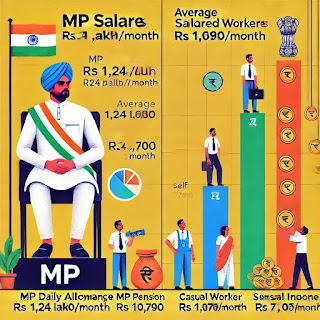The Central government has announced a 24% increase in the salaries and pensions of Members of Parliament (MPs) with retrospective effect from April 1, 2023. This decision has sparked debate, especially in light of the India Employment Report (IER) 2024, which highlights declining real wages for India's working population, widening the economic gap.
How Are MPs' Salaries Revised?
-
Legal Framework: Since 2018, MP salaries and pensions have been revised every five years based on the Cost Inflation Index (CII), eliminating the need for parliamentary approval.
-
Finance Act, 2018: This act amended the Salaries, Allowances, and Pension of Members of Parliament Act, 1954, enabling automatic revisions.
-
Cost Inflation Index (CII):
-
The CII for FY 2024-25 is 363, meaning prices have risen 3.63 times since 2001.
-
CII helps adjust salaries based on inflation, preventing MPs from facing real wage erosion.
-
What Does the IER 2024 Say About Wage Trends in India?
-
Decline in Real Wages:
-
Regular salaried workers: ₹10,925 (2022) → ₹10,790 (2023)
-
Casual workers: ₹4,712 (2022) → ₹4,671 (2023)
-
Self-employed earnings rose from ₹6,843 to ₹7,060 in the same period.
-
-
Gender Disparity: Women in self-employment and casual work saw a decline, while men in self-employment saw marginal gains.
-
Quality of Employment: Despite GDP growth, the stagnation in wages indicates weak employment generation.
Concerns: Rising Political Pay vs. Worker Wage Stagnation
1. Weakening of Democratic Accountability
-
India’s per capita income (2022-23): ₹1.72 lakh/year (~₹14,333/month)
-
MP pension: ₹31,000/month (2x average Indian income)
-
MP salary: ₹1.24 lakh/month (9x average Indian income)
-
This raises concerns about self-serving governance, public trust erosion, and a widening gap between leaders and citizens.
2. Asymmetry in Governance Priorities
-
MP salary hike (2025): 24%
-
National Floor Level Minimum Wage (NFLMW): ₹176/day (unchanged since 2017), among the lowest in Asia-Pacific.
-
Reflects a lack of urgency in improving workers' earnings.
3. Fueling Populism
-
Food inflation: 9.04% (2024)
-
Household savings: 5.3% of GDP (FY24)
-
High MP salaries + wage stagnation = greater dependence on freebies, reinforcing short-term populist politics over sustainable welfare reforms.
4. Undermining Inclusive Growth Goals
-
Wage disparity contradicts SDG 10: Reduced Inequalities, damaging India's global reputation as a growth-inclusive economy.
-
India’s Minimum Wages Act, 1948, does not address essential needs like housing, health, and education.
How Can India Bridge the Wage-Inflation Gap?
-
Independent Pay Commissions:
-
Depoliticize MP salary hikes with an independent Emoluments Commission, as suggested by the 14th Finance Commission.
-
-
Index Minimum Wages to Inflation:
-
Implement a National Wage Indexation Mechanism to stabilize real income.
-
-
Shift from Minimum Wage to Fair Wage:
-
Expand Article 43 of the Indian Constitution to define a decent standard of living, including health, education, and social mobility.
-
Align with ILO’s Decent Work Agenda and EU fair wage frameworks.
-
-
Enhancing Compliance via Digital Governance:
-
Use platforms like e-Shram, EPFO databases, and real-time reporting tools to ensure wage compliance.
-
-
8th Pay Commission for Wage Parity:
-
Link public and private sector wages to inflation and economic conditions for a balanced income structure.
-
Conclusion
The contrast between rising political salaries and stagnant worker wages raises serious governance and economic equity concerns. While MPs enjoy regular salary hikes, millions of Indian workers struggle with low wages and high inflation. Systemic reforms in wage policies, fair pay structures, and inflation-linked minimum wages are necessary to ensure inclusive economic growth and maintain public trust in governance.
📚📚Aspirants' useful contents? Click Here📖📖
🔗Follow for more content: Daily Current Affairs & Trending News



0 Comments